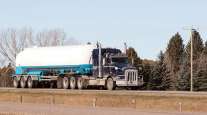Trucking Exec Tells Congress Hazmat Changes Needed
Trucking executive William Downey told the House Transportation and Infrastructure Committee on April 2 that changes are needed to improve the safety and security of hazardous material shipments.
Downey, executive vice president for corporate affairs and chief security officer with The Kenan Advantage Group, asked Congress to limit the requirement for fingerprint-based background checks for drivers transporting security-sensitive hazardous materials.
Testifying on behalf of American Trucking Associations, Downey told the panel’s railroads, pipelines and hazardous materials subcommittee that Congress should clarify accountability in hazmat transportation by distinguishing the functions performed by shippers versus those performed by carriers.
He said the government should reform the states’ hazmat-transportation permitting processes, and called on Congress to block proposed “wetline” regulations. Those would require that tank trucks be retrofitted with devices that would purge flammable liquids from lines that are not as well protected as the main tank.
Downey referenced a Government Accountability Office report that said the federal agency that regulates hazardous materials did not properly consider the costs and benefits of the proposed wetline mandate.
PHMSA Administrator Cythia Quarterman told the subcommittee that her agency is reviewing the GAO report and expects to decide whether it will withdraw its proposed wetlines rule “in the next few months.”
“Since the report, we have had teams working on data quality, especially with respect to unreported incidents,” Quarterman said. “We now do our own intelligence gathering, if you will, for incidents that are not reported to us. I think our data quality has significantly improved.”
But Downey said that in light of the critical GAO report other alternatives exist to help reduce wetlines incidents.
“Our position is that we can take the dollars that would be required to retrofit our trailers or buy new trailers and put those dollars to training and other types of technologies, such as anti-rollover stability equipment, that would prevent accidents,” Downey said.


